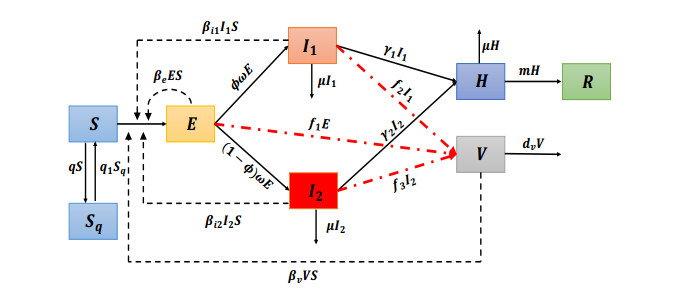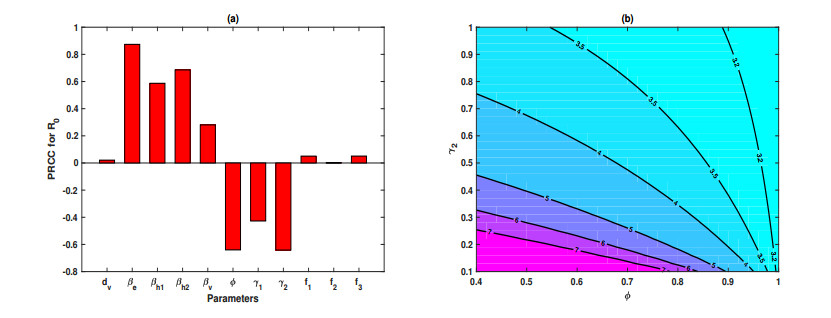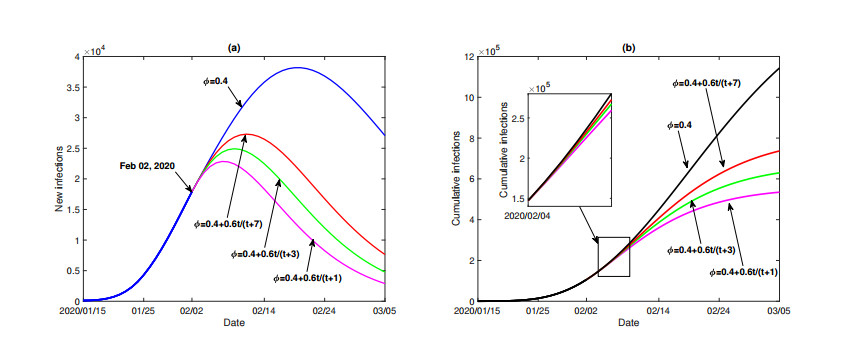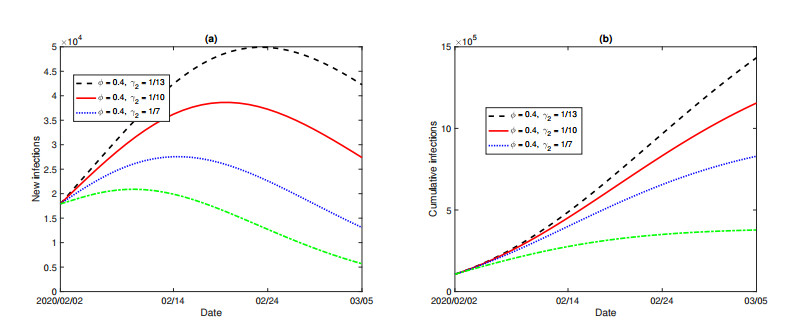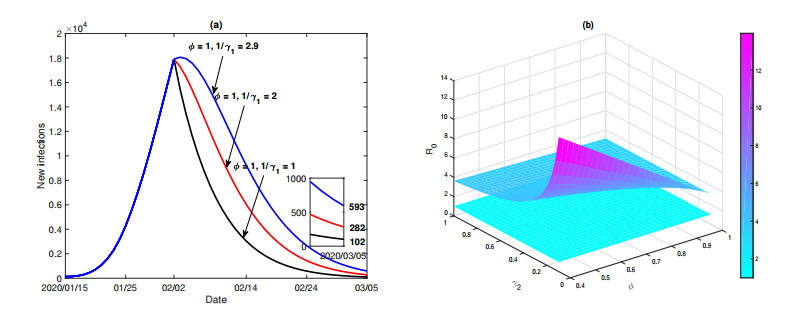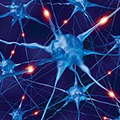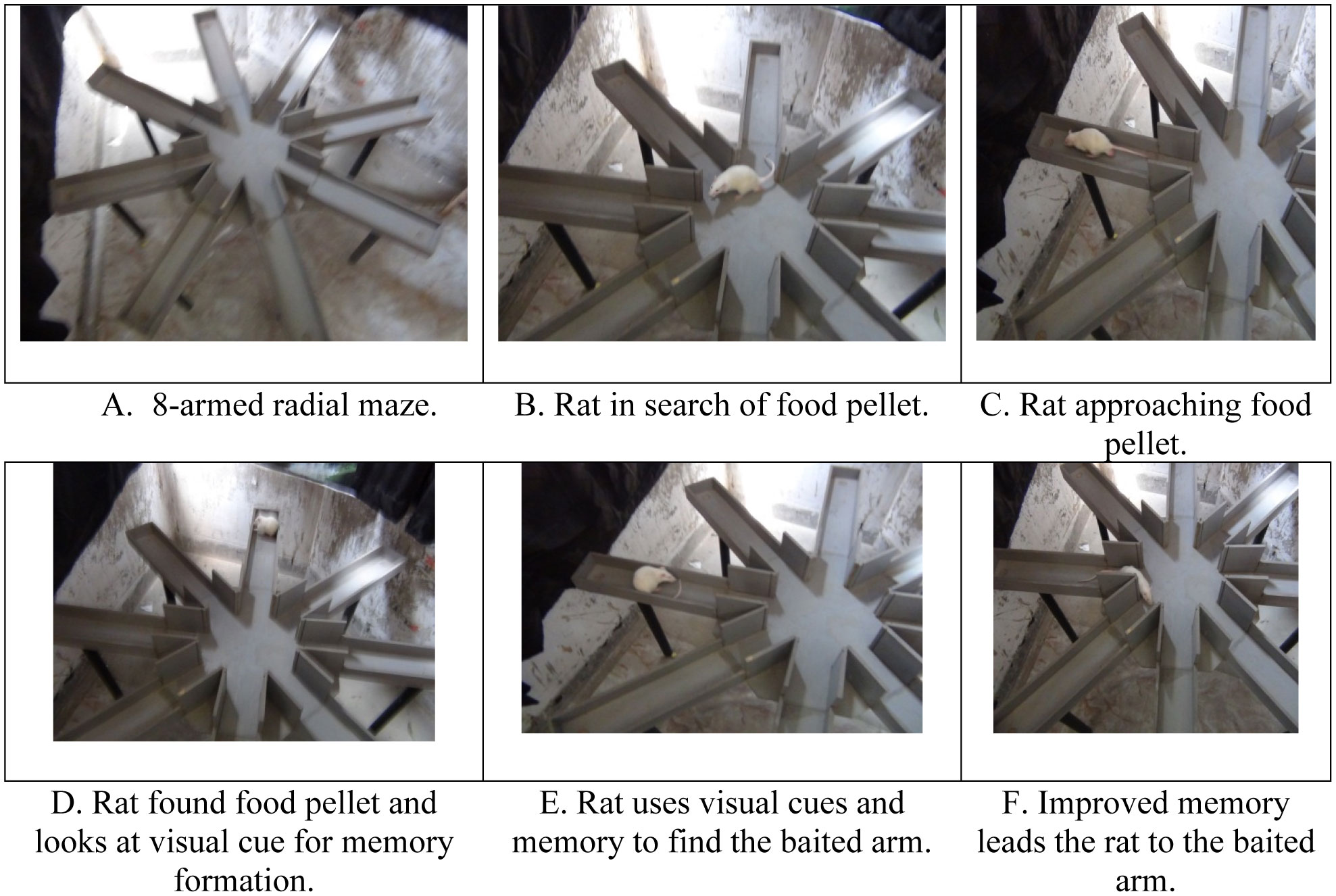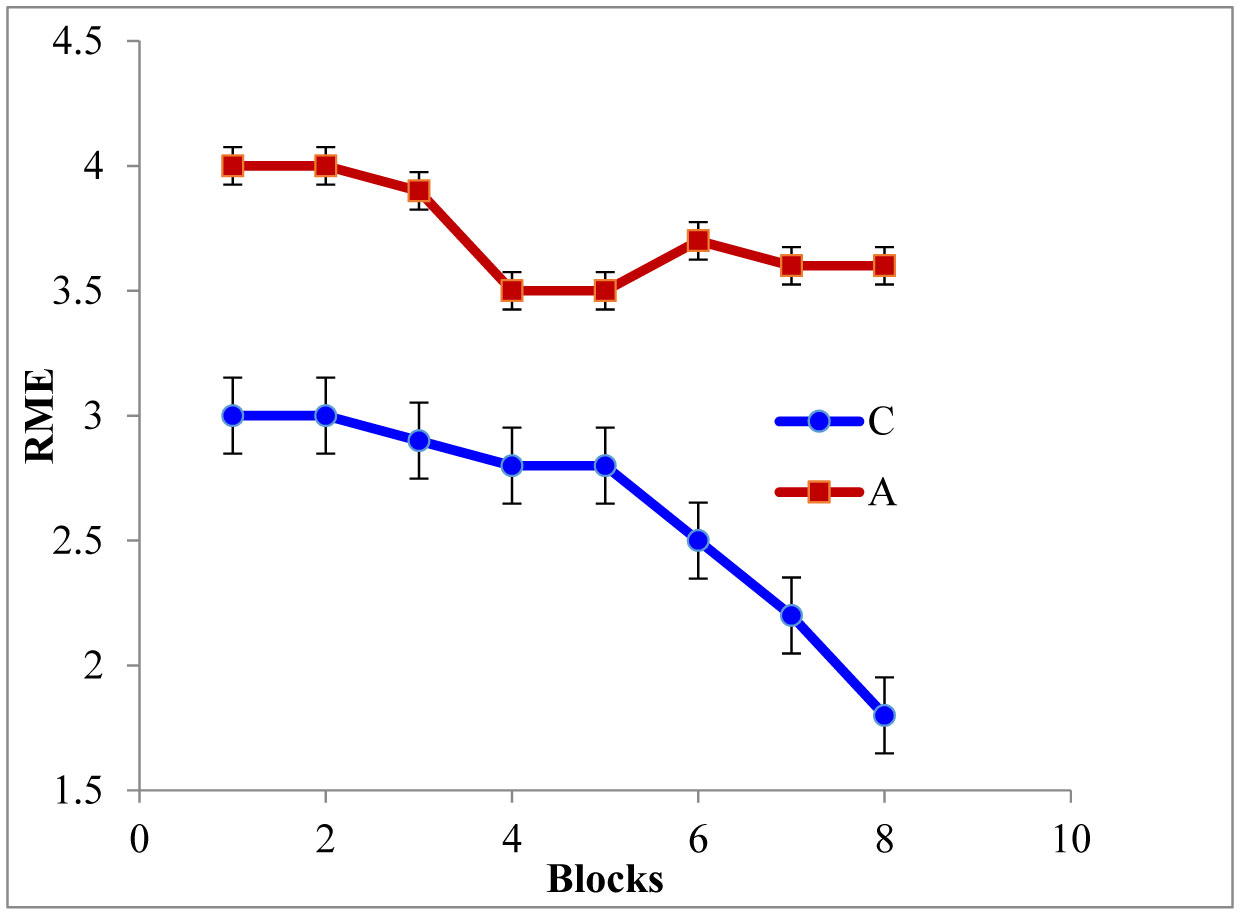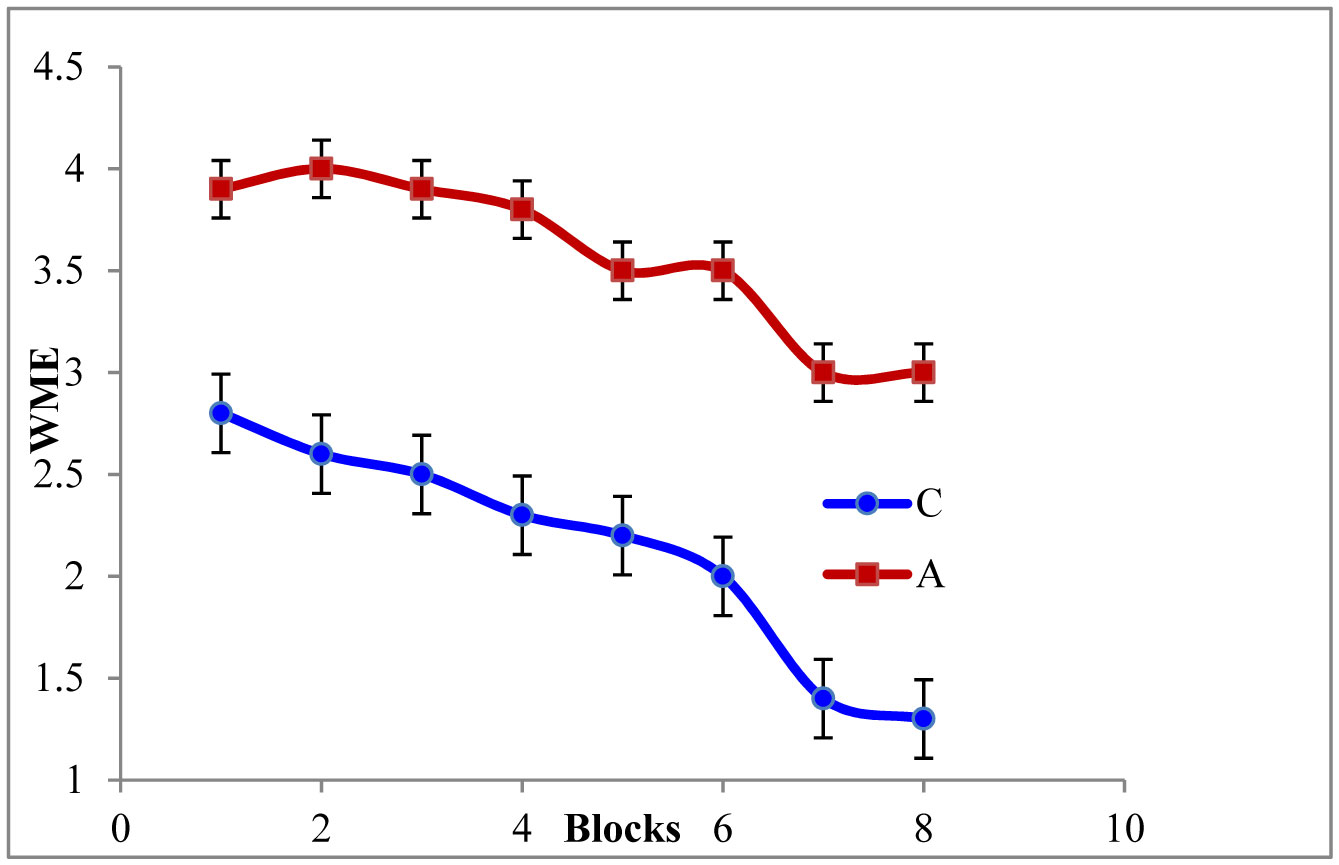| 1.
|
Keng-Wei Lee, Tsair-Wei Chien, Yu-Tsen Yeh, Willy Chou, Hsien-Yi Wang,
An online time-to-event dashboard comparing the effective control of COVID-19 among continents using the inflection point on an ogive curve,
2021,
100,
0025-7974,
e24749,
10.1097/MD.0000000000024749
|
|
| 2.
|
Aziz Eftekhari, Mahdieh Alipour, Leila Chodari, Solmaz Maleki Dizaj, Mohammadreza Ardalan, Mohammad Samiei, Simin Sharifi, Sepideh Zununi Vahed, Irada Huseynova, Rovshan Khalilov, Elham Ahmadian, Magali Cucchiarini,
A Comprehensive Review of Detection Methods for SARS-CoV-2,
2021,
9,
2076-2607,
232,
10.3390/microorganisms9020232
|
|
| 3.
|
Jianping Geng, Jun Yu, Tao Lu, Yinhe Wang, Yang Cao,
A Silent Infection Pandemic of COVID-19: Epidemiological Investigation and Hypothetical Models,
2020,
2020,
1712-9532,
1,
10.1155/2020/5120253
|
|
| 4.
|
Wei-Tsong Wang, Su-Ying Wu,
Knowledge management based on information technology in response to COVID-19 crisis,
2020,
1477-8238,
1,
10.1080/14778238.2020.1860665
|
|
| 5.
|
Prasantha Bharathi Dhandapani, Dumitru Baleanu, Jayakumar Thippan, Vinoth Sivakumar,
On stiff, fuzzy IRD-14 day average transmission model of COVID-19 pandemic disease,
2020,
7,
2375-1495,
208,
10.3934/bioeng.2020018
|
|
| 6.
|
Ali Moussaoui, Pierre Auger, E. Augeraud, M. Banerjee, J.-S. Dhersin, A. d'Onofrio, T. Lipniacki, S. Petrovskii, Chi Tran, A. Veber-Delattre, E. Vergu, V. Volpert,
Prediction of confinement effects on the number of Covid-19 outbreak in Algeria,
2020,
15,
0973-5348,
37,
10.1051/mmnp/2020028
|
|
| 7.
|
Joshua Asamoah, Zhen Jin, Baba Seidu, F.T. Odoro, Gui-Quan Sun, Faris Alzahrani,
Mathematical Modelling and Sensitivity Assessment of COVID-19 Outbreak for Ghana and Egypt,
2020,
1556-5068,
10.2139/ssrn.3612877
|
|
| 8.
|
Michael J. Loeffelholz, David Alland, Susan M. Butler-Wu, Utsav Pandey, Carlo Frederico Perno, Alice Nava, Karen C. Carroll, Heba Mostafa, Emma Davies, Ashley McEwan, Jennifer L. Rakeman, Randal C. Fowler, Jean-Michel Pawlotsky, Slim Fourati, Sukalyani Banik, Padmapriya P. Banada, Shobha Swaminathan, Soumitesh Chakravorty, Robert W. Kwiatkowski, Victor C. Chu, JoAnn Kop, Rajiv Gaur, Mandy L. Y. Sin, Duy Nguyen, Simranjit Singh, Na Zhang, David H. Persing, Alexander J. McAdam,
Multicenter Evaluation of the Cepheid Xpert Xpress SARS-CoV-2 Test,
2020,
58,
0095-1137,
10.1128/JCM.00926-20
|
|
| 9.
|
Isaac Owusu-Mensah, Lanre Akinyemi, Bismark Oduro, Olaniyi S. Iyiola,
A fractional order approach to modeling and simulations of the novel COVID-19,
2020,
2020,
1687-1847,
10.1186/s13662-020-03141-7
|
|
| 10.
|
Sanjeet Singh, Jayaram R.,
A Review of Potential Antiviral Drugs and Vaccines to Treat COVID-19,
2020,
14,
2581690X,
765,
10.22207/JPAM.14.SPL1.14
|
|
| 11.
|
Joshua Kiddy K. Asamoah, Zhen Jin, Gui-Quan Sun, Baba Seidu, Ernest Yankson, Afeez Abidemi, F.T. Oduro, Faris Alzahrani, Stephen E. Moore, Eric Okyere,
Sensitivity assessment and optimal economic evaluation of a new COVID-19 compartmental epidemic model with control interventions,
2021,
09600779,
110885,
10.1016/j.chaos.2021.110885
|
|
| 12.
|
Jianzhe Huang, Guoyuan Qi,
Effects of control measures on the dynamics of COVID-19 and double-peak behavior in Spain,
2020,
101,
0924-090X,
1889,
10.1007/s11071-020-05901-2
|
|
| 13.
|
Madeshwari Ezhilan, Indhu Suresh, Noel Nesakumar,
SARS-CoV, MERS-CoV and SARS-CoV-2: A Diagnostic Challenge,
2021,
168,
02632241,
108335,
10.1016/j.measurement.2020.108335
|
|
| 14.
|
Laio Magno, Thais Aranha Rossi, Fernanda Washington de Mendonça-Lima, Carina Carvalho dos Santos, Guilherme Barreto Campos, Lucas Miranda Marques, Marcos Pereira, Nilia Maria de Brito Lima Prado, Inês Dourado,
Desafios e propostas para ampliação da testagem e diagnóstico para COVID-19 no Brasil,
2020,
25,
1678-4561,
3355,
10.1590/1413-81232020259.17812020
|
|
| 15.
|
Daniele Lilleri, Federica Zavaglio, Elisa Gabanti, Giuseppe Gerna, Eloisa Arbustini, Patrick Tang,
Analysis of the SARS-CoV-2 epidemic in Italy: The role of local and interventional factors in the control of the epidemic,
2020,
15,
1932-6203,
e0242305,
10.1371/journal.pone.0242305
|
|
| 16.
|
Hend Alrasheed, Alhanoof Althnian, Heba Kurdi, Heila Al-Mgren, Sulaiman Alharbi,
COVID-19 Spread in Saudi Arabia: Modeling, Simulation and Analysis,
2020,
17,
1660-4601,
7744,
10.3390/ijerph17217744
|
|
| 17.
|
Lin-Yen Wang, Tsair-Wei Chien, Willy Chou,
Using the IPcase Index with Inflection Points and the Corresponding Case Numbers to Identify the Impact Hit by COVID-19 in China: An Observation Study,
2021,
18,
1660-4601,
1994,
10.3390/ijerph18041994
|
|
| 18.
|
Kyent-Yon Yie, Tsair-Wei Chien, Yu-Tsen Yeh, Willy Chou, Shih-Bin Su,
Using Social Network Analysis to Identify Spatiotemporal Spread Patterns of COVID-19 around the World: Online Dashboard Development,
2021,
18,
1660-4601,
2461,
10.3390/ijerph18052461
|
|
| 19.
|
Sijia Liu, Ni Yao, Yanru Qiu, Chengqi He,
Predictive performance of SOFA and qSOFA for in-hospital mortality in severe novel coronavirus disease,
2020,
38,
07356757,
2074,
10.1016/j.ajem.2020.07.019
|
|
| 20.
|
Giovanni Sotgiu, Claudia C. Dobler,
Social stigma in the time of coronavirus disease 2019,
2020,
56,
0903-1936,
2002461,
10.1183/13993003.02461-2020
|
|
| 21.
|
Ali Traoré, Fourtoua Victorien Konané,
Modeling the effects of contact tracing on COVID-19 transmission,
2020,
2020,
1687-1847,
10.1186/s13662-020-02972-8
|
|
| 22.
|
Afeez Abidemi, Zaitul Marlizawati Zainuddin, Nur Arina Bazilah Aziz,
Impact of control interventions on COVID-19 population dynamics in Malaysia: a mathematical study,
2021,
136,
2190-5444,
10.1140/epjp/s13360-021-01205-5
|
|
| 23.
|
K. N. Schneider, C. L. Correa-Martínez, G. Gosheger, C. Rickert, D. Schorn, A. Mellmann, V. Schwierzeck, S. Kampmeier,
Assessing the spreading potential of an undetected case of COVID-19 in orthopaedic surgery,
2020,
0936-8051,
10.1007/s00402-020-03516-1
|
|
| 24.
|
Feng Zhou, Chong You, Xiaoyu Zhang, Kaihuan Qian, Yan Hou, Yanhui Gao, Xiao-Hua Zhou,
Epidemiological Characteristics and Factors Associated with Critical Time Intervals of COVID-19 in Eighteen Provinces, China: A Retrospective Study,
2021,
102,
12019712,
123,
10.1016/j.ijid.2020.09.1487
|
|
| 25.
|
Yushan Wu, Xiang Yan, Shi Zhao, Jingxuan Wang, Jinjun Ran, Dong Dong, Maggie Wang, Hong Fung, Eng-kiong Yeoh, Roger Yat-Nork Chung,
Association of time to diagnosis with socioeconomic position and geographical accessibility to healthcare among symptomatic COVID-19 patients: A retrospective study in Hong Kong,
2020,
66,
13538292,
102465,
10.1016/j.healthplace.2020.102465
|
|
| 26.
|
Xinchen Yu, Guoyuan Qi, Jianbing Hu,
Analysis of second outbreak of COVID-19 after relaxation of control measures in India,
2020,
0924-090X,
10.1007/s11071-020-05989-6
|
|
| 27.
|
P.H.T. Schimit,
A model based on cellular automata to estimate the social isolation impact on COVID-19 spreading in Brazil,
2021,
200,
01692607,
105832,
10.1016/j.cmpb.2020.105832
|
|
| 28.
|
Christopher R. Carpenter, Philip A. Mudd, Colin P. West, Erin Wilber, Scott T. Wilber, Shahriar Zehtabchi,
Diagnosing COVID‐19 in the Emergency Department: A Scoping Review of Clinical Examinations, Laboratory Tests, Imaging Accuracy, and Biases,
2020,
27,
1069-6563,
653,
10.1111/acem.14048
|
|
| 29.
|
Yong Li, Lian-Wen Wang, Zhi-Hang Peng, Hong-Bing Shen,
Basic reproduction number and predicted trends of coronavirus disease 2019 epidemic in the mainland of China,
2020,
9,
2049-9957,
10.1186/s40249-020-00704-4
|
|
| 30.
|
Nour K. Younis, Rana O. Zareef, Mohammad Ali N. Maktabi, Rami Mahfouz,
The Era of the Coronavirus Disease 2019 Pandemic: A Review on Dynamics, Clinical Symptoms and Complications, Diagnosis, and Treatment,
2021,
25,
1945-0265,
85,
10.1089/gtmb.2020.0227
|
|
| 31.
|
Heungsup Sung, Myung-Guk Han, Cheon-Kwon Yoo, Sang-Won Lee, Yoon-Seok Chung, Jae-Sun Park, Mi-Na Kim, Hyukmin Lee, Ki Ho Hong, Moon-Woo Seong, Kyunghoon Lee, Sail Chun, Wee Gyo Lee, Gye-Cheol Kwon, Won-Ki Min,
Nationwide External Quality Assessment of SARS-CoV-2 Molecular Testing, South Korea,
2020,
26,
1080-6040,
2353,
10.3201/eid2610.202551
|
|
| 32.
|
Olumuyiwa James Peter, Sania Qureshi, Abdullahi Yusuf, Mohammed Al-Shomrani, Abioye Abioye Idowu,
A new mathematical model of COVID-19 using real data from Pakistan,
2021,
24,
22113797,
104098,
10.1016/j.rinp.2021.104098
|
|
| 33.
|
Nicola Serra, Paola Di Carlo, Teresa Rea, Consolato M. Sergi,
Diffusion modeling of COVID-19 under lockdown,
2021,
33,
1070-6631,
041903,
10.1063/5.0044061
|
|
| 34.
|
Anna-Leena Lohiniva, Timothee Dub, Lotta Hagberg, Hanna Nohynek, Jennifer Yourkavitch,
Learning about COVID-19-related stigma, quarantine and isolation experiences in Finland,
2021,
16,
1932-6203,
e0247962,
10.1371/journal.pone.0247962
|
|
| 35.
|
Ketki Jawade, Akhauri Yash Sinha, Sharad Bhagat, Shilpa Bhowmick, Bhagyashree Chauhan, Snehal Kaginkar, Harsha Palav, Nandini Kasarpalkar, Pratik Devadiga, Kalyani Karandikar, Sachee Agarwal, Jayanthi Shastri, Kiran Munne, Vikrant M. Bhor, Smita D. Mahale, Subhanjan Bhowmik, Dhanashree Jagtap, Vainav Patel,
A novel ORF-1a based SARS-CoV-2 RT-PCR assay to resolve inconclusive samples,
2021,
12019712,
10.1016/j.ijid.2021.04.006
|
|
| 36.
|
Matthew O. Adewole, Akindele A. Onifade, Farah A. Abdullah, Funmilayo Kasali, Ahmad I. M. Ismail,
Modeling the Dynamics of COVID-19 in Nigeria,
2021,
7,
2349-5103,
10.1007/s40819-021-01014-5
|
|
| 37.
|
Ayfer Ozturk,
Stigmatization spreads faster than the virus. Viruses do not discriminate, and neither should we.” Combatting the stigmatization surrounding coronavirus disease (COVID‐19) pandemic,
2021,
0031-5990,
10.1111/ppc.12815
|
|
| 38.
|
Jonghoo Lee, Jae‐Uk Song,
Diagnostic accuracy of the Cepheid Xpert Xpress and the Abbott ID NOW assay for rapid detection of SARS‐CoV‐2: A systematic review and meta‐analysis,
2021,
0146-6615,
10.1002/jmv.26994
|
|
| 39.
|
S.O. Akindeinde, Eric Okyere, A.O. Adewumi, R.S. Lebelo, Olanrewaju. O. Fabelurin, Stephen. E. Moore,
Caputo Fractional-order SEIRP model for COVID-19 epidemic,
2021,
11100168,
10.1016/j.aej.2021.04.097
|
|
| 40.
|
Tsz-Lik Chan, Hsiang-Yu Yuan, Wing-Cheong Lo,
Modeling COVID-19 Transmission Dynamics With Self-Learning Population Behavioral Change,
2021,
9,
2296-2565,
10.3389/fpubh.2021.768852
|
|
| 41.
|
Florina Silvia Iliescu, Ana Maria Ionescu, Larisa Gogianu, Monica Simion, Violeta Dediu, Mariana Carmen Chifiriuc, Gratiela Gradisteanu Pircalabioru, Ciprian Iliescu,
Point-of-Care Testing—The Key in the Battle against SARS-CoV-2 Pandemic,
2021,
12,
2072-666X,
1464,
10.3390/mi12121464
|
|
| 42.
|
H. Rwezaura, S.Y. Tchoumi, J.M. Tchuenche,
Impact of environmental transmission and contact rates on Covid-19 dynamics: A simulation study,
2021,
27,
23529148,
100807,
10.1016/j.imu.2021.100807
|
|
| 43.
|
Sina Ahmadi, Seyed Fahim Irandoost, Ahmad Ahmadi, Javad Yoosefi Lebni, Mohammad Ali Mohammadi Gharehghani, Nafe Baba Safari,
Explaining Experiences, Challenges and Adaptation Strategies in COVID-19 Patients: A Qualitative Study in Iran,
2022,
9,
2296-2565,
10.3389/fpubh.2021.778026
|
|
| 44.
|
Neera Marathe, Aashutosh Asati, Alok Pratap Singh, Manoj Indurkar, Saritesh Kuma Thakur,
Epidemiological Factors and Clinical Course of COVID-19 in Patients Who Died Following the Disease in Dedicated COVID Hospital, Rewa District, Madhya Pradesh - A Retrospective Study,
2021,
8,
23492562,
1739,
10.18410/jebmh/2021/329
|
|
| 45.
|
Abdulla All Noman, Mustafizur Rahaman, Tahmid Hasan Pranto, Rashedur M. Rahman,
Blockchain for medical collaboration: A federated learning-based approach for multi-class respiratory disease classification,
2023,
3,
27724425,
100135,
10.1016/j.health.2023.100135
|
|
| 46.
|
Xinyu Liu, Yuting Ding,
Stability and Numerical Simulations of a New SVIR Model with Two Delays on COVID-19 Booster Vaccination,
2022,
10,
2227-7390,
1772,
10.3390/math10101772
|
|
| 47.
|
Jianbing Hu, Guoyuan Qi, Xinchen Yu, Lin Xu,
Modeling and staged assessments of the controllability of spread for repeated outbreaks of COVID-19,
2021,
106,
0924-090X,
1411,
10.1007/s11071-021-06568-z
|
|
| 48.
|
Getachew Beyecha Batu, Eshetu Dadi Gurmu,
Mathematical Model of the Transmission Dynamics of Novel Corona Virus (COVID-19) Pandamic Disease with Optimal Control,
2021,
15,
1998-0140,
195,
10.46300/9101.2021.15.27
|
|
| 49.
|
Gianni Gori Savellini, Gabriele Anichini, Chiara Terrosi, Shibily Prathyumnan, Claudia Gandolfo, Stefano Marini, Maria Grazia Cusi, Kileen L. Shier,
Comparative Performance of a New SARS-CoV-2 Rapid Detection System,
2021,
9,
2165-0497,
10.1128/Spectrum.00205-21
|
|
| 50.
|
Kang-Ting Tsai, Tsair-Wei Chien, Ju-Kuo Lin, Yu-Tsen Yeh, Willy Chou,
Comparison of prediction accuracies between mathematical models to make projections of confirmed cases during the COVID-19 pandamic by country/region,
2021,
100,
0025-7974,
e28134,
10.1097/MD.0000000000028134
|
|
| 51.
|
Sacrifice Nana-Kyere, Francis Agyei Boateng, Paddy Jonathan, Anthony Donkor, Glory Kofi Hoggar, Banon Desmond Titus, Daniel Kwarteng, Isaac Kwasi Adu, Andrei Korobeinikov,
Global Analysis and Optimal Control Model of COVID-19,
2022,
2022,
1748-6718,
1,
10.1155/2022/9491847
|
|
| 52.
|
Chunxia Cao, Yue Li, Shaobo Fu, Yongzhong Zhang, Ning Li, Shike Hou, Haojun Fan,
Patient delay in a coronavirus disease 2019 (COVID-19) outbreak in Tianjin, China from January to February 2020,
2022,
121,
09296646,
1248,
10.1016/j.jfma.2021.11.003
|
|
| 53.
|
Wei Deng, Guoyuan Qi, Xinchen Yu,
Optimal control strategy for COVID-19 concerning both life and economy based on deep reinforcement learning*
,
2021,
30,
1674-1056,
120203,
10.1088/1674-1056/ac3229
|
|
| 54.
|
Maheswari Rangasamy, Nazek Alessa, Prasantha Bharathi Dhandapani, Karuppusamy Loganathan,
Dynamics of a Novel IVRD Pandemic Model of a Large Population over a Long Time with Efficient Numerical Methods,
2022,
14,
2073-8994,
1919,
10.3390/sym14091919
|
|
| 55.
|
Xiangyun Shi, Xiwen Gao, Xueyong Zhou, Yongfeng Li,
Analysis of an SQEIAR epidemic model with media coverage and asymptomatic infection,
2021,
6,
2473-6988,
12298,
10.3934/math.2021712
|
|
| 56.
|
Innokentiy A. Kastalskiy, Evgeniya V. Pankratova, Evgeny M. Mirkes, Victor B. Kazantsev, Alexander N. Gorban,
Social stress drives the multi-wave dynamics of COVID-19 outbreaks,
2021,
11,
2045-2322,
10.1038/s41598-021-01317-z
|
|
| 57.
|
Yinan Cai, Michael W. Golay,
A dynamic Bayesian network‐based emergency decision‐making framework highlighting emergency propagations: Illustrated using the Fukushima nuclear accidents and the Covid‐19 pandemic,
2022,
0272-4332,
10.1111/risa.13928
|
|
| 58.
|
Stephen E. Moore, Hetsron L. Nyandjo-Bamen, Olivier Menoukeu-Pamen, Joshua Kiddy K. Asamoah, Zhen Jin,
Global stability dynamics and sensitivity assessment of COVID-19 with timely-delayed diagnosis in Ghana,
2022,
10,
2544-7297,
87,
10.1515/cmb-2022-0134
|
|
| 59.
|
Ichiro Nakamoto, Jilin Zhang,
Modeling the underestimation of COVID-19 infection,
2021,
25,
22113797,
104271,
10.1016/j.rinp.2021.104271
|
|
| 60.
|
Jinxing Guan, Yang Zhao, Yongyue Wei, Sipeng Shen, Dongfang You, Ruyang Zhang, Theis Lange, Feng Chen,
Transmission dynamics model and the coronavirus disease 2019 epidemic: applications and challenges,
2022,
2,
2749-9642,
89,
10.1515/mr-2021-0022
|
|
| 61.
|
Maheswari Rangasamy, Christophe Chesneau, Carlos Martin-Barreiro, Víctor Leiva,
On a Novel Dynamics of SEIR Epidemic Models with a Potential Application to COVID-19,
2022,
14,
2073-8994,
1436,
10.3390/sym14071436
|
|
| 62.
|
Janelle Patel, Nikki Christofferson, Kellie J. Goodlet,
Pharmacist-provided SARS-CoV-2 testing targeting a majority-Hispanic community during the early COVID-19 pandemic: Results of a patient perception survey,
2022,
62,
15443191,
187,
10.1016/j.japh.2021.08.015
|
|
| 63.
|
Sharifah Norsyahindah Syed Nor, Nur Syafiqah Rasanang, Salmah Karman, Wan Safwani Wan Kamarul Zaman, Sulaiman Wadi Harun, Hamzah Arof,
A Review: Surface Plasmon Resonance-Based Biosensor for Early Screening of SARS-CoV2 Infection,
2022,
10,
2169-3536,
1228,
10.1109/ACCESS.2021.3138981
|
|
| 64.
|
Hua-Ying Chuang, Tsair-Wei Chien, Willy Chou, Chen-Yu Wang, Kang-Ting Tsai,
Comparison of prediction accuracies between two mathematical models for the assessment of COVID-19 damage at the early stage and throughout 2020,
2022,
101,
1536-5964,
e29718,
10.1097/MD.0000000000029718
|
|
| 65.
|
Jiandong Lu, Xiaolei Wang, Liguo Fei, Guo Chen, Yuqiang Feng,
Effects of social media empowerment on COVID-19 preventive behaviors in China,
2023,
0959-3845,
10.1108/ITP-05-2022-0412
|
|
| 66.
|
Joyce Owens Kobusingye, Mitima Jean-Marie Limenyande, Harriet Mayinja,
Impact of turnaround time in delivery of Covid-19 results and surveillance: a case of points of entry, Uganda,
2022,
5,
2664-2824,
10.37432/jieph.supp.2022.5.1.04.1
|
|
| 67.
|
Edward Acheampong, Eric Okyere, Samuel Iddi, Joseph H.K. Bonney, Joshua Kiddy K. Asamoah, Jonathan A.D. Wattis, Rachel L. Gomes,
Mathematical modelling of earlier stages of COVID-19 transmission dynamics in Ghana,
2022,
34,
22113797,
105193,
10.1016/j.rinp.2022.105193
|
|
| 68.
|
Ismaïl Alsaïdi, Frédéric De Sousa Santos, Bérengère Plard, Elise Janvier, Aurélie Tinland, Abdelmajid Hafni, Emilie Mosnier,
Factors associated with SARS-CoV2 infection and care pathways among the most vulnerable populations living in Marseille: a case control study,
2021,
21,
1471-2458,
10.1186/s12889-021-11716-6
|
|
| 69.
|
Jeong Su Park,
The More You Know about COVID-19 Diagnostic Testing, the More You Understand,
2021,
26,
2671-9886,
45,
10.14192/kjicp.2021.26.2.45
|
|
| 70.
|
Parvaiz Ahmad Naik, Jian Zu, Muhammad Bilal Ghori, Mehraj-ud-din Naik,
Modeling the effects of the contaminated environments on COVID-19 transmission in India,
2021,
29,
22113797,
104774,
10.1016/j.rinp.2021.104774
|
|
| 71.
|
Yung-Shuo Kao, Kun-Te Lin,
A Meta-Analysis of Computerized Tomography-Based Radiomics for the Diagnosis of COVID-19 and Viral Pneumonia,
2021,
11,
2075-4418,
991,
10.3390/diagnostics11060991
|
|
| 72.
|
Gunnar Völkel, Axel Fürstberger, Julian D Schwab, Silke D Werle, Nensi Ikonomi, Thomas Gscheidmeier, Johann M Kraus, Alexander Groß, Martin Holderried, Julien Balig, Franz Jobst, Peter Kuhn, Klaus A Kuhn, Oliver Kohlbacher, Udo X Kaisers, Thomas Seufferlein, Hans A Kestler,
Patient Empowerment During the COVID-19 Pandemic by Ensuring Safe and Fast Communication of Test Results: Implementation and Performance of a Tracking System,
2021,
23,
1438-8871,
e27348,
10.2196/27348
|
|
| 73.
|
Lasko Basnarkov, Igor Tomovski, Trifce Sandev, Ljupco Kocarev,
Non-Markovian SIR epidemic spreading model of COVID-19,
2022,
160,
09600779,
112286,
10.1016/j.chaos.2022.112286
|
|
| 74.
|
Sofia K. Mettler, Jewel Park, Orhun Özbek, Linus K. Mettler, Po-Han Ho, Hye Chang Rhim, Marloes H. Maathuis,
The importance of timely contact tracing — A simulation study,
2021,
108,
12019712,
309,
10.1016/j.ijid.2021.04.029
|
|
| 75.
|
Nam Xuan Ha, Truong Le-Van, Nguyen Hai Nam, Akshay Raut, Joseph Varney, Nguyen Tien Huy,
A problem of self-isolation in Japan: The relationship between self-isolation and COVID-19 community case,
2022,
12,
2228-6497,
192,
10.34172/hpp.2022.24
|
|
| 76.
|
Dewa Putu Wiadnyana Putra, Marcellinus Andy Rudhito,
2022,
2575,
0094-243X,
030001,
10.1063/5.0108052
|
|
| 77.
|
Michael A. Rowland, Todd M. Swannack, Michael L. Mayo, Matthew Parno, Matthew Farthing, Ian Dettwiller, Glover George, William England, Molly Reif, Jeffrey Cegan, Benjamin Trump, Igor Linkov, Brandon Lafferty, Todd Bridges,
COVID-19 infection data encode a dynamic reproduction number in response to policy decisions with secondary wave implications,
2021,
11,
2045-2322,
10.1038/s41598-021-90227-1
|
|
| 78.
|
Silvana Nair Leite, Jorge Antonio Zepeda Bermudez, Débora Melecchi, Adelir Rodrigues da Veiga, Ana Liani Beisl Oliveira, Artur Custódio Moreira de Sousa, Célia Machado Gervásio Chaves, Fernanda Manzini, Lidiane Silva Dutra, Luísa Arueira Chaves, Marco Aurélio Pereira, Maria Eufrásia Oliveira Lima, Moysés Longinho Toniolo, Ronald Ferreira dos Santos, Silvânia Dantas, Jorge Carlos Santos da Costa,
Projeto Integra: fortalecimento da participação social na agenda das políticas, serviços e tecnologias em saúde,
2021,
26,
1678-4561,
5589,
10.1590/1413-812320212611.18212021
|
|
| 79.
|
Fatemeh Asadi-Mehregan, Pouria Assari, Mehdi Dehghan,
The numerical solution of a mathematical model of the Covid-19 pandemic utilizing a meshless local discrete Galerkin method,
2022,
0177-0667,
10.1007/s00366-022-01749-9
|
|
| 80.
|
Suresh K. Joishy, Michito Sadohara, Masaru Kurihara, Yasuharu Tokuda,
Complexity of the Diagnosis of COVID-19 in the Context of Pandemicity: Need for Excellence in Diagnostic Acumen,
2022,
43,
2092-6715,
16,
10.4082/kjfm.20.0188
|
|
| 81.
|
Somjit Nath, Mayank Baranwal, Harshad Khadilkar,
2021,
Revisiting State Augmentation methods for Reinforcement Learning with Stochastic Delays,
9781450384469,
1346,
10.1145/3459637.3482386
|
|
| 82.
|
Mahender Aileni, Gulab Khan Rohela, Phanikanth Jogam, Shakuntala Soujanya, Baohong Zhang,
Biotechnological Perspectives to Combat the COVID-19 Pandemic: Precise Diagnostics and Inevitable Vaccine Paradigms,
2022,
11,
2073-4409,
1182,
10.3390/cells11071182
|
|
| 83.
|
Chadia Haddad, Sandrella Bou Malhab, Diana Malaeb, Hala Sacre, Danielle Saadeh, Vanessa Mourtada, Pascale Salameh,
Stigma toward people with COVID-19 among the Lebanese population: a cross-sectional study of correlates and mediating effects,
2021,
9,
2050-7283,
10.1186/s40359-021-00646-y
|
|
| 84.
|
Gokul Chandra Biswas, Swapnila Choudhury, Mohammad Mahbub Rabbani, Jagotamoy Das,
A Review on Potential Electrochemical Point-of-Care Tests Targeting Pandemic Infectious Disease Detection: COVID-19 as a Reference,
2022,
10,
2227-9040,
269,
10.3390/chemosensors10070269
|
|
| 85.
|
Xinmiao Rong, Huidi Chu, Liu Yang, Shaosi Tan, Chao Yang, Pei Yuan, Yi Tan, Linhua Zhou, Yawen Liu, Qing Zhen, Shishen Wang, Meng Fan, Huaiping Zhu,
Recursive Zero-COVID model and quantitation of control efforts of the Omicron epidemic in Jilin province,
2023,
8,
24680427,
11,
10.1016/j.idm.2022.11.007
|
|
| 86.
|
Lingyun Zhu, Wei Dong, Qing Sun, Esteban Abelardo Hernandez Vargas, Xin Du,
2021,
Estimation of the Unreported Infections of COVID-19 based on an Extended Stochastic Susceptible-Exposed-Infective-Recovered Model,
978-1-6654-2423-3,
953,
10.1109/DDCLS52934.2021.9455548
|
|
| 87.
|
Rishabh Khatri, Jay Patel, Jun Song, Henry P. Parkman,
New-onset functional dyspepsia after COVID-19,
2023,
4,
2691-3895,
e0266,
10.1097/MD9.0000000000000266
|
|
| 88.
|
Adam Sadowski, Zbigniew Galar, Robert Walasek, Grzegorz Zimon, Per Engelseth,
Big data insight on global mobility during the Covid-19 pandemic lockdown,
2021,
8,
2196-1115,
10.1186/s40537-021-00474-2
|
|
| 89.
|
Keren Dopelt, Nadav Davidovitch, Nikol Davidov, Ira Plot, Hagai Boas, Paul Barach,
“As if we are branded with the mark of Cain”: stigma, guilt, and shame experienced by COVID-19 survivors in Israel - a qualitative study,
2023,
1046-1310,
10.1007/s12144-023-04241-9
|
|
| 90.
|
Guihong Fan, Juan Li, Jacques Bélair, Huaiping Zhu,
Delayed Model for the Transmission and Control of COVID-19 with Fangcang Shelter Hospitals,
2023,
83,
0036-1399,
276,
10.1137/21M146154X
|
|
| 91.
|
Jayanta Kumar Ghosh, Sudhanshu Kumar Biswas, Susmita Sarkar, Uttam Ghosh,
Mathematical modelling of COVID-19: A case study of Italy,
2022,
194,
03784754,
1,
10.1016/j.matcom.2021.11.008
|
|
| 92.
|
Katherine South, Suzanne Bakken, Theresa Koleck, Veronica Barcelona, Noemie Elhadad, Caitlin Dreisbach,
Women’s Experiences of Symptoms of Suspected or Confirmed COVID-19 Illness During the Pandemic,
2022,
26,
17514851,
450,
10.1016/j.nwh.2022.09.005
|
|
| 93.
|
Katie Hogan, Briana Macedo, Venkata Macha, Arko Barman, Xiaoqian Jiang,
Contact Tracing Apps: Lessons Learned on Privacy, Autonomy, and the Need for Detailed and Thoughtful Implementation,
2021,
9,
2291-9694,
e27449,
10.2196/27449
|
|
| 94.
|
Daw-Hsin Yang, Tsair-Wei Chien, Yu-Tsen Yeh, Ting-Ya Yang, Willy Chou, Ju-Kuo Lin,
Using the absolute advantage coefficient (AAC) to measure the strength of damage hit by COVID-19 in India on a growth-share matrix,
2021,
26,
2047-783X,
10.1186/s40001-021-00528-4
|
|
| 95.
|
Rico Januar Sitorus, Irzanita Wathan, Hibsah Ridwan, Hariadi Wibisono, Lesti Nuraini, Gandi Kosim, Nugi Nurdin, Hatta Mamat, Iche Andrayani, Nyoman Yudi Antara, Merry Natalia,
Transmission dynamics of novel Coronavirus–SARS-CoV-2 in South Sumatera, Indonesia,
2021,
11,
22133984,
100777,
10.1016/j.cegh.2021.100777
|
|
| 96.
|
Jonghoo Lee, Jae-Uk Song, Sung Ryul Shim,
Comparing the diagnostic accuracy of rapid antigen detection tests to real time polymerase chain reaction in the diagnosis of SARS-CoV-2 infection: A systematic review and meta-analysis,
2021,
144,
13866532,
104985,
10.1016/j.jcv.2021.104985
|
|
| 97.
|
Yue Deng, Siming Xing, Meixia Zhu, Jinzhi Lei,
Impact of insufficient detection in COVID-19 outbreaks,
2021,
18,
1551-0018,
9727,
10.3934/mbe.2021476
|
|
| 98.
|
Gokul Chandra Biswas, Md. Taufiqur Mannan Khan, Jagotamoy Das,
Wearable nucleic acid testing platform - A perspective on rapid self-diagnosis and surveillance of infectious diseases,
2023,
226,
09565663,
115115,
10.1016/j.bios.2023.115115
|
|
| 99.
|
Sam Yu-Chieh Ho, Tsair-Wei Chien, Yang Shao, Ju-Hao Hsieh,
Visualizing the features of inflection point shown on a temporal bar graph using the data of COVID-19 pandemic,
2022,
101,
0025-7974,
e28749,
10.1097/MD.0000000000028749
|
|
| 100.
|
Olumuyiwa J. Peter, Amjad S. Shaikh, Mohammed O. Ibrahim, Kottakkaran Sooppy Nisar, Dumitru Baleanu, Ilyas Khan, Adesoye I. Abioye,
Analysis and Dynamics of Fractional Order Mathematical Model of COVID-19 in Nigeria Using Atangana-Baleanu Operator,
2021,
66,
1546-2226,
1823,
10.32604/cmc.2020.012314
|
|
| 101.
|
Iulian A. Bratu, Lucian C. Dinca, Cristian M. Enescu, Mirela Stanciu,
The Role of Social Media in Public Forest Management Policies during COVID-19: Implications for Stakeholder Engagement,
2022,
14,
2071-1050,
3778,
10.3390/su14073778
|
|
| 102.
|
Linhua Zhou, Xinmiao Rong, Meng Fan, Liu Yang, Huidi Chu, Ling Xue, Guorong Hu, Siyu Liu, Zhijun Zeng, Ming Chen, Wei Sun, Jiamin Liu, Yawen Liu, Shishen Wang, Huaiping Zhu,
Modeling and Evaluation of the Joint Prevention and Control Mechanism for Curbing COVID-19 in Wuhan,
2022,
84,
0092-8240,
10.1007/s11538-021-00983-4
|
|
| 103.
|
Olaniyi Iyiola, Bismark Oduro, Trevor Zabilowicz, Bose Iyiola, Daniel Kenes,
System of Time Fractional Models for COVID-19: Modeling, Analysis and Solutions,
2021,
13,
2073-8994,
787,
10.3390/sym13050787
|
|
| 104.
|
A. Ya. Nikitin, M. V. Chesnokova, S. V. Balakhonov,
Algorithm and Results of Short-Term Forecast of Changes in the COVID-19 Spread Coefcient in the Constituent Entities of the Russian Federation,
2021,
2658-719X,
98,
10.21055/0370-1069-2021-3-98-105
|
|
| 105.
|
Julliana Gonçalves Marques, Luiz Affonso Guedes, Márjory Cristiany da Costa Abreu,
Evaluating Time Influence over Performance of Machine-Learning-Based Diagnosis: A Case Study of COVID-19 Pandemic in Brazil,
2022,
20,
1660-4601,
136,
10.3390/ijerph20010136
|
|
| 106.
|
Justin M. Calabrese, Jeffery Demers,
How optimal allocation of limited testing capacity changes epidemic dynamics,
2022,
538,
00225193,
111017,
10.1016/j.jtbi.2022.111017
|
|
| 107.
|
M. Abdelhakem, A. Ahmed, D. Baleanu, M. El-kady,
Monic Chebyshev pseudospectral differentiation matrices for higher-order IVPs and BVPs: applications to certain types of real-life problems,
2022,
41,
2238-3603,
10.1007/s40314-022-01940-0
|
|
| 108.
|
Mastaneh Alinezhadi, Niloofar Neisi, Mojtaba Rasti, Maniya Arshadi, Mehdi Parsanahad, Bahman Cheraghian,
Evaluation of False Negative Among SARS-COV-2 Patients with Negative Real-time PCR Result Using Nested-RT PCR,
2022,
15,
2008-3645,
10.5812/jjm-122889
|
|
| 109.
|
Rhys P.D. Inward, Felix Jackson, Abhishek Dasgupta, Graham Lee, Anya Lindström Battle, Kris V. Parag, Moritz U.G. Kraemer,
Impact of spatiotemporal heterogeneity in COVID-19 disease surveillance on epidemiological parameters and case growth rates,
2022,
41,
17554365,
100627,
10.1016/j.epidem.2022.100627
|
|
| 110.
|
Ahuod S. Alsheri, Aeshah A. Alraeza, Mona R. Afia,
Mathematical modeling of the effect of quarantine rate on controlling the infection of COVID19 in the population of Saudi Arabia,
2022,
61,
11100168,
6843,
10.1016/j.aej.2021.12.033
|
|
| 111.
|
Sabuj Kanti Mistry, A. R. M. Mehrab Ali, Uday Narayan Yadav, Md. Nazmul Huda, Md. Mahmudur Rahman, Manika Saha, Md. Ashfikur Rahman, David Lim, Saruna Ghimire,
Stigma toward people with COVID-19 among Bangladeshi older adults,
2022,
10,
2296-2565,
10.3389/fpubh.2022.982095
|
|
| 112.
|
Kassiani Mellou, Spyros Sapounas, Ioannis Panagoulias, Maria Gkova, Kalliopi Papadima, Anastasia Andreopoulou, Danai Kalotychou, Michalis Chatzopoulos, Kassiani Gkolfinopoulou, Vassiliki Papaevangelou, Sotirios Tsiodras, Georgios Panagiotakopoulos, Theoklis Zaoutis, Dimitrios Paraskevis,
Time Lag between COVID-19 Diagnosis and Symptoms Onset for Different Population Groups: Evidence That Self-Testing in Schools Was Associated with Timely Diagnosis among Children,
2022,
12,
2075-1729,
1305,
10.3390/life12091305
|
|
| 113.
|
Ofosuhene O. Apenteng, Bismark Oduro, Isaac Owusu-Mensah,
A compartmental model to investigate the dynamics of the COVID-19 pandemic: A case study in five countries,
2021,
14,
1793-5245,
2150027,
10.1142/S1793524521500273
|
|
| 114.
|
Abdullah Khamis Alzahrani, Oyoon Abdul Razzaq, Najeeb Alam Khan, Ali Saleh Alshomrani, Malik Zaka Ullah,
Transmissibility of epidemic diseases caused by delay with local proportional fractional derivative,
2021,
2021,
1687-1847,
10.1186/s13662-021-03435-4
|
|
| 115.
|
Seyed Ali Rakhshan, Mahdi Soltani Nejad, Marzie Zaj, Fatemeh Helen Ghane,
Global analysis and prediction scenario of infectious outbreaks by recurrent dynamic model and machine learning models: A case study on COVID-19,
2023,
00104825,
106817,
10.1016/j.compbiomed.2023.106817
|
|
| 116.
|
Sebastian Sattler, Dina Maskileyson, Eric Racine, Eldad Davidov, Alice Escande,
Stigmatization in the context of the COVID-19 pandemic: a survey experiment using attribution theory and the familiarity hypothesis,
2023,
23,
1471-2458,
10.1186/s12889-023-15234-5
|
|
| 117.
|
Yijun Lou, Feng-Bin Wang,
A Reaction-Diffusion Model with Spatially Inhomogeneous Delays,
2023,
1040-7294,
10.1007/s10884-023-10254-6
|
|
| 118.
|
Sulifu Bao, Zhi-Hua Hu, Xiaohui Wang,
An integrated optimization control model of combining epidemic and production–inventory models and its numerical simulations,
2023,
126,
10075704,
107490,
10.1016/j.cnsns.2023.107490
|
|
| 119.
|
Prasantha Bharathi Dhandapani, Víctor Leiva, Carlos Martin-Barreiro, Maheswari Rangasamy,
On a Novel Dynamics of a SIVR Model Using a Laplace Adomian Decomposition Based on a Vaccination Strategy,
2023,
7,
2504-3110,
407,
10.3390/fractalfract7050407
|
|
| 120.
|
Xueru Xu, Li Luo, Huyang Xu, Yuanchen Fang,
The emergency hierarchical medical system in China: Improving patient waiting times and operation management,
2024,
17,
2047-9700,
660,
10.1080/20479700.2023.2229525
|
|
| 121.
|
Ali Azargoonjahromi,
Role of the SARS-CoV-2 Virus in Brain Cells,
2024,
37,
0882-8245,
61,
10.1089/vim.2023.0116
|
|
| 122.
|
Shimeng Dong, Jinlong Lv, Wanbiao Ma, Boralahala Gamage Sampath Aruna Pradeep,
A COVID-19 Infection Model Considering the Factors of Environmental Vectors and Re-Positives and Its Application to Data Fitting in Japan and Italy,
2023,
15,
1999-4915,
1201,
10.3390/v15051201
|
|
| 123.
|
Teddy Lazebnik,
Computational applications of extended SIR models: A review focused on airborne pandemics,
2023,
483,
03043800,
110422,
10.1016/j.ecolmodel.2023.110422
|
|
| 124.
|
Padma Bhushan Borah, Hemanta Kumar Sarmah,
2024,
Chapter 41,
978-3-031-52964-1,
517,
10.1007/978-3-031-52965-8_41
|
|
| 125.
|
Marwa Gamal, M. El-Kady, M. Abdelhakem,
Solving real-life BVPs via the second derivative Chebyshev pseudo-Galerkin method,
2024,
35,
0129-1831,
10.1142/S012918312450089X
|
|
| 126.
|
Neville J. Ford,
Mathematical modelling of problems with delay and after-effect,
2024,
01689274,
10.1016/j.apnum.2024.10.007
|
|
| 127.
|
德玉 郭,
A Dynamics Model of COVID-19 with Transition from the Asymptomatic to the Symptomatic Infected Individuals,
2023,
12,
2324-7991,
2457,
10.12677/AAM.2023.125248
|
|
| 128.
|
Atifa Sarwar, Abdulsalam Almadani, Emmanuel O. Agu,
Few-shot meta-learning for pre-symptomatic detection of Covid-19 from limited health tracker data,
2024,
32,
23526483,
100459,
10.1016/j.smhl.2024.100459
|
|
| 129.
|
Chuanqing Xu, Zonghao Zhang, Xiaotong Huang, Kedeng Cheng, Songbai Guo, Xiaojing Wang, Maoxing Liu, Xiaoling Liu,
A study on the transmission dynamics of COVID-19 considering the impact of asymptomatic infection,
2023,
17,
1751-3758,
10.1080/17513758.2023.2244980
|
|
| 130.
|
Akanksha Jain, Sonia Bajaj, Parag Jain, Ashish Majumdar, Ayushi Singh, Pranay Soni,
A review on biotechnologically derived techniques to combat COVID-19 situation,
2023,
8,
27726320,
100112,
10.1016/j.hsr.2023.100112
|
|
| 131.
|
Laura A. Rodríguez-Villamizar, Alexander Torres Prieto, Ruth A. Martínez-Vega, Lina M. Vera-Cala,
Epidemia por COVID-19 en Santander 2020: análisis epidemiológico desde un enfoque territorial por provincias,
2022,
53,
01210807,
10.18273/saluduis.53.e:21040
|
|
| 132.
|
Elham Sabouri, Amin Saburi, Reza Gerami, Tina Zeraati, Ehsan Saburi, Mostafa Ghanei,
Computerized Intelligence and Mathematical Models for COVID-19 Diagnosis: A Review,
2023,
9,
2322-1143,
55,
10.61186/jhehp.9.2.55
|
|
| 133.
|
Dina Abdelhamid, Wedad Albalawi, Kottakkaran Sooppy Nisar, A. Abdel-Aty, Suliman Alsaeed, M. Abdelhakem,
Mixed Chebyshev and Legendre polynomials differentiation matrices for solving initial-boundary value problems,
2023,
8,
2473-6988,
24609,
10.3934/math.20231255
|
|
| 134.
|
Emeka F. Obiajulu, Andrew Omame, Simeon C. Inyama, Uchenna H. Diala, Salman A. AlQahtani, Mabrook S. Al-Rakhami, Abdulaziz M. Alawwad, Abdullilah A. Alotaibi,
Analysis of a non-integer order mathematical model for double strains of dengue and COVID-19 co-circulation using an efficient finite-difference method,
2023,
13,
2045-2322,
10.1038/s41598-023-44825-w
|
|
| 135.
|
Ali Hadianfar, Sedigheh Rastaghi, Hamed Tabesh, Azadeh Saki,
Application of distributed lag models and spatial analysis for comparing the performance of the COVID-19 control decisions in European countries,
2023,
13,
2045-2322,
10.1038/s41598-023-44830-z
|
|
| 136.
|
S. Swetha, S. Sindu Devi, K. Kannan,
Optimal Control Strategies for COVID-19 Using SEIQR Mathematical Model,
2024,
0369-8203,
10.1007/s40010-024-00898-4
|
|
| 137.
|
Hassan A. Alsattar, Sarah Qahtan, Aws Alaa Zaidan, Muhammet Deveci, Luis Martinez, Dragan Pamucar, Witold Pedrycz,
Developing deep transfer and machine learning models of chest X-ray for diagnosing COVID-19 cases using probabilistic single-valued neutrosophic hesitant fuzzy,
2024,
236,
09574174,
121300,
10.1016/j.eswa.2023.121300
|
|
| 138.
|
Michael Fralick, Jason A. Moggridge, Makenna Wiebe, Lucas Castellani, Allison McGeer, Bryan Feenstra, Aaron Hinz, Alexandra M.A. Hicks, Laura A. Hug, Alex Wong, Tamara Van Bakel, Sawith Abeygunawardena, Tasha Burhunduli, Hebah S. Mejbel, Rees Kassen, Nisha Thampi, Derek MacFadden, Caroline Nott,
SARS-CoV-2 burden on the floor was associated with COVID-19 cases and outbreaks in two acute care hospitals: a prospective cohort study,
2024,
0899-823X,
1,
10.1017/ice.2024.121
|
|
| 139.
|
Alexis Dorta-Gorrín, Jesús Navas-Méndez, Mónica Gozalo-Margüello, Laura Miralles, Lorena García-Hevia,
Detection of SARS-CoV-2 Based on Nucleic Acid Amplification Tests (NAATs) and Its Integration into Nanomedicine and Microfluidic Devices as Point-of-Care Testing (POCT),
2023,
24,
1422-0067,
10233,
10.3390/ijms241210233
|
|
| 140.
|
勇盛 赵,
Dynamical Analysis of a COVID-19 Transmission Model with Vaccination,
2024,
13,
2324-7991,
1187,
10.12677/aam.2024.134109
|
|
| 141.
|
Raheleh Khanduzi, Amin Jajarmi, Asiyeh Ebrahimzadeh, Mehdi Shahini,
A novel collocation method with a coronavirus optimization algorithm for the optimal control of COVID-19: A case study of Wuhan, China,
2024,
178,
00104825,
108680,
10.1016/j.compbiomed.2024.108680
|
|
| 142.
|
Mohamed Amouch, Noureddine Karim,
Fractional-order mathematical modeling of COVID-19 dynamics with different types of transmission,
2023,
0,
2155-3289,
0,
10.3934/naco.2023019
|
|
| 143.
|
Sulifu Bao, Zhi-Hua Hu,
A new model of the transmission dynamics of COVID-19 propagation with vaccination and recommended treatments,
2023,
111,
0924-090X,
20465,
10.1007/s11071-023-08914-9
|
|
| 144.
|
S. Sankaranarayanan,
An approach to statistical analysis-using the average transmission model of Covid 19,
2020,
8,
23193786,
2158,
10.26637/MJM0804/0141
|
|
| 145.
|
Rico Januar Sitorus, Hariadi Wibisono, Hibsah Ridwan, Nyoman Yudi Antara, Merry Natalia Panjaitan, Reymart V. Sangalang,
TRACING OF COVID-19 TRANSMISSION BASED ON CLOSE CONTACT POPULATION: CASES IN SOUTH SUMATRA,
2023,
11,
2541-092X,
9,
10.20473/jbe.V11I12023.9-16
|
|
| 146.
|
Nicholas P. McCormick, Oluchukwu M. Ezeala, Spencer H. Durham, Salisa C. Westrick,
Assessing barriers to COVID-19 diagnostic testing in community pharmacies: Insights from Alabama,
2024,
15443191,
102286,
10.1016/j.japh.2024.102286
|
|
| 147.
|
Ruchi Bhoot, Suved Sanjay Ghanmode, Yogesh Simmhan,
TARIS: Scalable Incremental Processing of Time-Respecting Algorithms on Streaming Graphs,
2024,
35,
1045-9219,
2527,
10.1109/TPDS.2024.3471574
|
|
| 148.
|
Lidong Zhou, Qixing Han,
The threshold of a stochastic SIVS model with saturated incidence based on logarithmic Ornstein-Uhlenbeck process,
2025,
0022247X,
129253,
10.1016/j.jmaa.2025.129253
|
|
| 149.
|
Younes Mousania, Salman Karimi, Ali Farmani,
Designing High-Performance SPR Biosensor Using Hybrid Structure of BifeO3 and 2D Material for SARS-CoV-2 Detection,
2025,
1557-1963,
10.1007/s11468-024-02516-w
|
|
| 150.
|
Haibo Bao, Ye He,
Epidemic dynamics with awareness cascade of positive and negative information on delayed multiplex networks,
2025,
35,
1054-1500,
10.1063/5.0247513
|
|
| 151.
|
Alberto Landi, Giulio Pisaneschi, Marco Laurino, Piero Manfredi,
Optimal social distancing in pandemic preparedness and lessons from COVID-19: Intervention intensity and infective travelers,
2025,
604,
00225193,
112072,
10.1016/j.jtbi.2025.112072
|
|
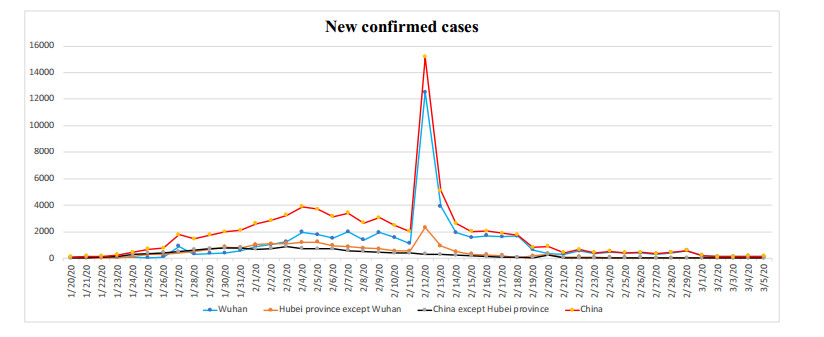









 DownLoad:
DownLoad:
